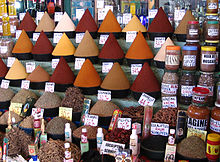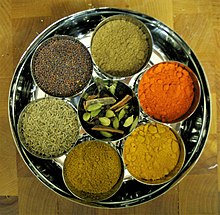
Back Spesery Afrikaans Especia AN بهارات Arabic ليستة التوابل والبهارات ARZ Especie (sustancia) AST Manq'a sumachiri Aymara Ədviyyat Azerbaijani ادویات AZB Gwiaz BAR Rekado BCL
In the culinary arts, a spice is any seed, fruit, root, bark, or other plant substance in a form primarily used for flavoring or coloring food. Spices are distinguished from herbs, which are the leaves, flowers, or stems of plants used for flavoring or as a garnish. Spices are sometimes used in medicine, religious rituals, cosmetics, or perfume production. They are usually classified into spices, spice seeds, and herbal categories.[1]For example, vanilla is commonly used as an ingredient in fragrance manufacturing.[2] Plant-based sweeteners such as sugar are not considered spices.
Spices may be used fresh and whole, after drying, grating, chopping, crushing, or grinding, or by extraction into a tincture. Such processing may happen before a spice is offered for sale, while preparing a dish in a kitchen, or after a dish has been presented for consumption (such as peppercorns ground at the table as a condiment). Some spices such as turmeric are seldom available either fresh or whole and so must be purchased in ground form. Small seeds such as fennel or mustard may be used either whole or in powdered form.
A whole dried spice has the longest shelf life, so it can be purchased and stored in larger amounts, making it cheaper on a per-serving basis. A fresh spice, such as ginger, is usually more flavorful than its dried form, but fresh spices are more expensive and have a much shorter shelf life.
There is not enough clinical evidence to indicate that consuming spices affects human health.[3]
India contributes to 75% of global spice production.[citation needed] This is reflected culturally through its cuisine. Historically, the spice trade developed throughout the Indian subcontinent as well as in East Asia and the Middle East. Europe's demand for spices was among the economic and cultural factors that encouraged exploration in the early modern period.
- ^ "Spice and herb | Types, Uses, & Facts | Britannica". www.britannica.com. March 8, 2024. Retrieved April 9, 2024.
- ^ Ahmad, Hafsa; Khera, Rasheed Ahmad; Hanif, Muhammad Asif; Ayub, Muhammad Adnan; Jilani, Muhammad Idrees (2020). "Vanilla". Medicinal Plants of South Asia. pp. 657–669. doi:10.1016/B978-0-08-102659-5.00048-3. ISBN 978-0-08-102659-5. S2CID 241855294.
- ^ Vázquez-Fresno, Rosa; Rosana, Albert Remus R.; Sajed, Tanvir; et al. (May 22, 2019). "Herbs and Spices - Biomarkers of Intake Based on Human Intervention Studies – A Systematic Review". Genes and Nutrition. 14 (18): 18. doi:10.1186/s12263-019-0636-8. PMC 6532192. PMID 31143299.
© MMXXIII Rich X Search. We shall prevail. All rights reserved. Rich X Search


